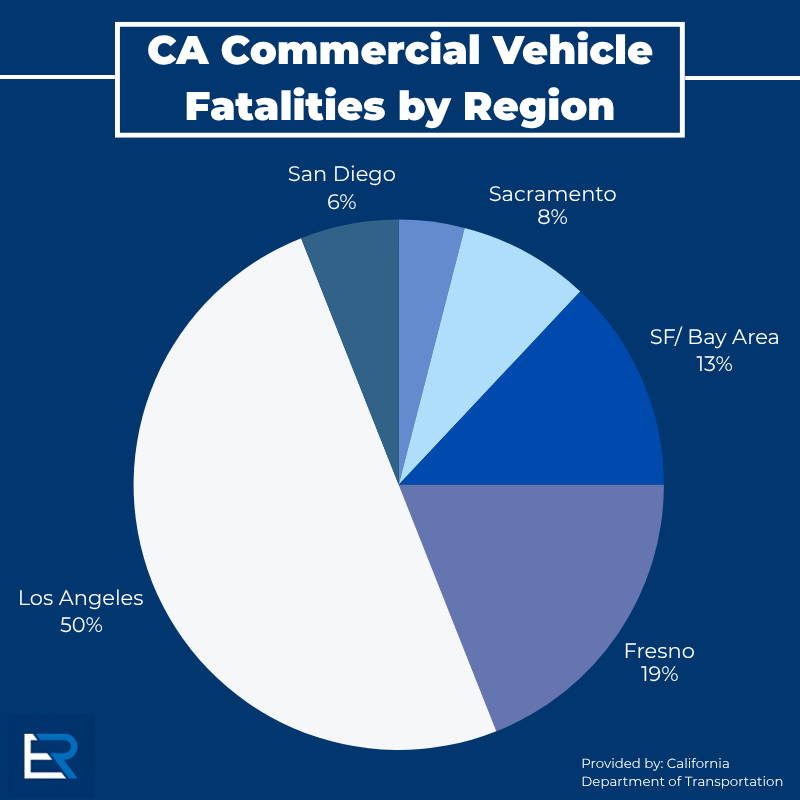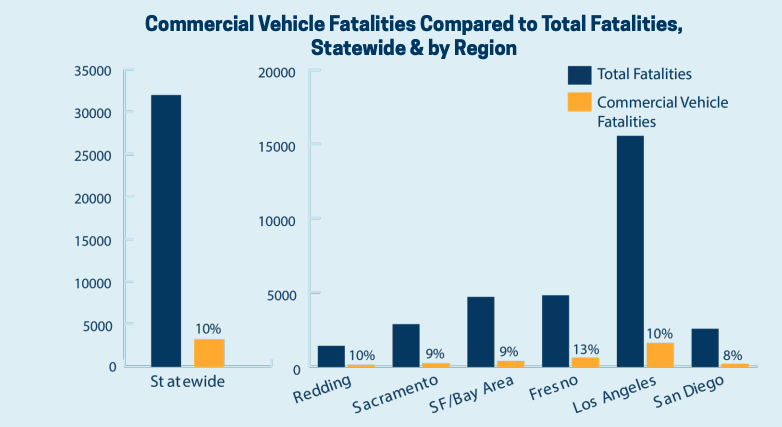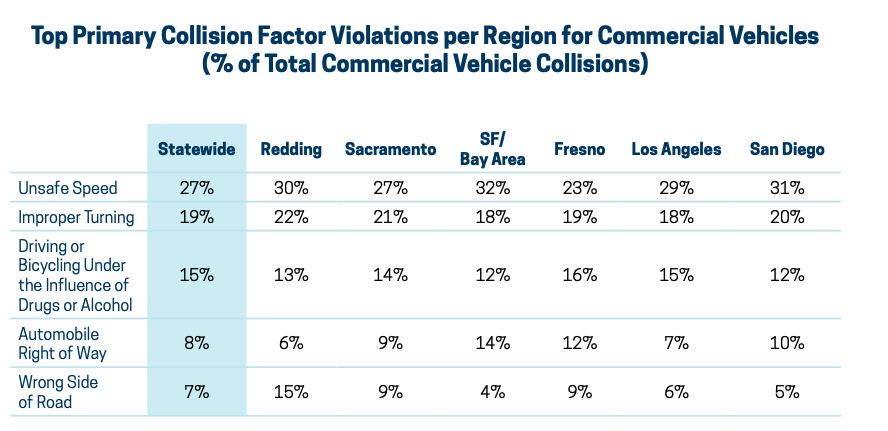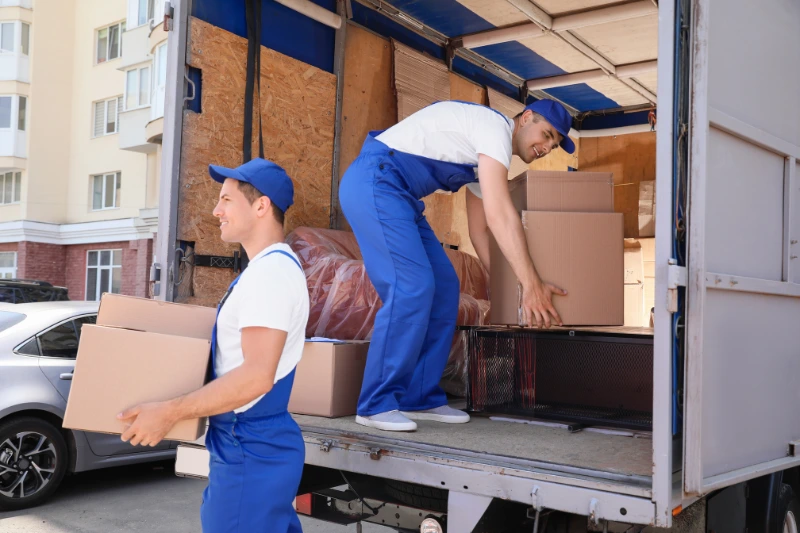You see them every day: towering trucks rumbling down California’s highways, hauling everything from fresh produce to construction materials.
What you don’t see is the network behind each one: trucking companies setting deadlines, cargo crews loading freight, mechanics handling repairs, and manufacturers supplying critical parts. Each of these players has a role in keeping trucks safe, and when one fails, the consequences can be devastating.
That’s why, when a truck accident occurs, the cause often goes far beyond the driver. Any one of these parties could share responsibility for what went wrong, and knowing who they are is the first step toward holding them accountable.
Why California’s Truck Accident Statistics Should Concern Every Driver
California is one of the busiest freight hubs in the country, with thousands of commercial trucks moving goods between ports, warehouses, and cities every day.
This heavy truck presence increases the chances of serious crashes, especially on high-speed highways. The latest data shows just how often and where these deadly collisions are happening.

A closer look at the California commercial vehicle fatalities shows:
- Nearly 50% of all fatal truck crashes happen in the greater Los Angeles region.
- 19% occur in the Fresno region.
- 13% happen in the San Francisco/ Bay Area region.
- Most deadly collisions happen on state highways, where high speeds make the impact even worse.

Statewide, about 10% of all traffic fatalities involve commercial vehicles, but the risk is even higher in some regions. The greater Los Angeles region leads in total fatalities, while Fresno matches its 13% share of deaths linked to commercial vehicles despite having fewer crashes overall.
These numbers show that both high-traffic cities and smaller freight-heavy regions face serious dangers from truck accidents.
And instead of going down, the problem is getting worse: between 2008 and 2017, fatalities and serious injuries from commercial truck crashes increased by 17%. Each statistic represents real people, families suddenly facing hospital bills, lost income, and life-changing injuries.
That’s why finding every party responsible is so critical. Our California truck accident attorneys know how to dig deep, uncover the truth, and fight for the full compensation you deserve.
Mapping California’s Most Dangerous Roads for Truck Crashes
Truck accidents in California often cluster in the same dangerous locations. High-traffic freight routes like the 10 Freeway in Loma Linda and the 60 Freeway in Ontario in San Bernardino County, as well as the 91 Freeway in Paramount in Los Angeles County, see some of the highest crash numbers each year.
By knowing these high-risk locations, you can better understand where accidents are most likely and why. Here are some common hotspots throughout California:
| County | Freeway & City | Number of Crashes |
| San Bernardino County | 10 Fwy – Loma Linda | 385 |
| San Bernardino County | 60 Fwy – Ontario | 274 |
| Los Angeles County | 91 Fwy – Paramount | 95 |
| Los Angeles County | 5 Fwy – Commerce | 71 |
| Los Angeles County | 10 Fwy – West Covina | 68 |
| Fresno County | 180 Fwy – Fresno | 41 |
| Fresno County | 269 Fwy – Huron | 15 |
| San Francisco County | 101 Fwy – San Francisco | 11 |
| San Francisco County | 80 Fwy – San Francisco | 8 |
Statistics provided by: Transportation Injury Mapping System by UC Berkeley
Who Can Be Held Liable for a Truck Accident in California?
When a truck accident happens, most people assume the truck driver is the only one to blame. In reality, assigning liability is often a more complex process. Multiple people or companies may have played a role, sometimes in ways you’d never expect.
Identifying every responsible party is one of the most important steps after a crash. It can mean the difference between a settlement that barely covers your bills and one that fully supports your recovery. In California, some of the parties who may share responsibility include:
The Truck Driver – Negligence Behind the Wheel
Many truck crashes start with a driver’s bad decisions. Statewide collision statistics show that 27% of commercial vehicle collisions involve unsafe speeding, and 15% involve driving under the influence of drugs or alcohol.

Research from the Insurance Institute for Highway Safety (IIHS) has also found that truck drivers behind the wheel for more than eight hours are twice as likely to crash. Long work hours can cause sleep deprivation, disrupt normal rest cycles, and lead to dangerous fatigue, making accidents far more likely. Here are some other common examples of truck driver negligence:
| Common examples of driver negligence include: |
| Driving too many hours without rest |
| Speeding or driving too fast for road conditions |
| Using a phone while driving |
| Driving under the influence of drugs or alcohol |
The Trucking Company – Pushing the Limits
Trucking companies aren’t just responsible for moving goods; they’re responsible for doing it safely. Unfortunately, some trucking companies and their insurers put profit before safety. Some companies cut corners, creating dangerous conditions that put everyone on the road at risk.
| A trucking company may be at fault if it: |
| Pushes drivers to meet unrealistic deadlines, causing speeding, skipped rest breaks, and fatigue. |
| Fails to train or screen drivers, leading to unqualified or unsafe operators on the road. |
| Skips inspections and maintenance, allowing dangerous mechanical issues to go unfixed. |
When a company is responsible, it often means there’s larger commercial insurance coverage available. This can be critical for covering the high costs of medical treatment, lost income, and the long-term impact of your injuries.
Our truck accident attorneys know how to hold these companies accountable and pursue the maximum compensation you deserve. Contact us today for a free consultation!
Recommended Reading:
- Why Truck Maintenance Records Matter After an Accident
- How to File a Truck Accident Claim in California
Cargo Loaders and Shipping Companies – Dangerous Loads

Not all truck accidents are caused by bad driving. Sometimes, the danger starts long before the truck ever hits the road, at the loading dock. An overloaded or improperly secured cargo can throw off a truck’s balance, make it harder to stop, or even spill onto the roadway, causing danger for everyone nearby.
| Cargo loading companies and shipping contractors may be responsible if they: |
| Exceeding legal weight limits makes the truck harder to control. |
| Fail to secure cargo with proper straps, locks, or restraints. |
| Distribute weight unevenly, increasing the risk of rollovers. |
By investigating the loading process, reviewing shipping records, and working with accident reconstruction experts, our legal team can uncover whether cargo issues played a role in your crash and hold every responsible party accountable.
Maintenance Providers – Bad Repairs and Missed Problems
Not all truck accidents are caused by driver error. In many cases, the problem starts with the truck itself. If a repair shop or maintenance crew provides inadequate service or overlooks a serious safety issue, they can be held liable for the results.
Likewise, when a truck or one of its parts is defectively designed, poorly manufactured, or sold without proper warnings, the manufacturer may be responsible under product liability laws.
Brake defects are one of the most common and dangerous problems. Brake defects were found in 42% of crash-involved trucks investigated, and when severe enough to place the truck out of service, they tripled the risk of a crash.
Having any vehicle defect, whether it’s brakes, steering, or another critical component, was linked to a 200% increase in crash risk.
| Common maintenance and manufacturing issues include: |
| Worn or defective brake systems |
| Tires prone to blowouts |
| Defective trailer hitches or coupling devices |
| Faulty steering components |
Holding manufacturers accountable not only helps victims recover the compensation they need for medical bills, lost income, and pain and suffering, but it can also lead to recalls and safety improvements that prevent future tragedies.
Our legal team works with engineering experts to uncover defects and build strong cases against negligent manufacturers.
Other Drivers – Chain Reaction Crashes
Not every truck accident is the truck driver’s fault. In many cases, another motorist’s careless or reckless behavior is what sets the crash in motion. A car might cut off a truck without leaving enough stopping distance, make a sudden lane change, or brake abruptly in heavy traffic, forcing the truck driver to swerve or slam on the brakes.
These split-second decisions can lead to multi-vehicle collisions with devastating results.
In California, comparative fault laws allow responsibility to be shared among everyone whose actions contributed to the crash. That means even if a truck driver or trucking company is partially at fault, another driver’s dangerous maneuver could also be held accountable.
Identifying and proving the role of these other drivers is critical to making sure you recover the maximum compensation available.
Government Agencies – Unsafe Roads
Poor road design, lack of warning signs, or dangerous construction zones can also lead to truck accidents. When a government agency or contractor is responsible, special rules and short deadlines apply, sometimes as little as six months to file a claim.
How Tracking Down All At-Fault Parties Protects Your Recovery
Truck accidents are often complicated. More than one party might share responsibility, which means you could have multiple insurance claims and more opportunities for full recovery.
Missing even one responsible party could mean missing out on the compensation you need for:
- Medical treatment now and in the future.
- Lost income.
- Pain and suffering.
It’s also important to act quickly. In California, you generally have two years from the date of the accident to file a personal injury claim. If a government agency is involved, such as Caltrans for unsafe road conditions, you may have as little as six months to file a claim.
Waiting too long can result in losing your right to recover damages, even if your case is strong!
How We Build Strong Cases for Truck Accident Claims
After a truck accident, you may be facing serious injuries, medical bills, missed work, and calls from insurance companies. Trying to handle all of this on your own can be overwhelming, especially when multiple parties may be at fault. That’s where our truck accident attorney comes in.
Our experienced truck accident lawyer can:
- Investigate the accident – Collect police reports, witness statements, black box data, and other key evidence.
- Identify all liable parties – From the driver to the trucking company, cargo loaders, and even parts manufacturers.
- Handle insurer negotiations from start to finish – Handle all communication so you don’t get pressured into a low settlement.
- Calculate the full value of your claim – Include medical expenses, lost income, future treatment, and pain and suffering.
- Meet legal deadlines – Especially important if a government agency is involved, where you may have only six months to file a claim.
- Fight for maximum compensation – Whether through negotiation or in court.
At El Dabe Ritter Trial Lawyers, we don’t just build cases; we protect your future. Your first consultation is free, and you pay nothing unless we win. The sooner you contact us, the sooner we can secure evidence and start fighting for your rights.
Injured in a Truck Accident? Let’s Discuss Your Case at No Cost!

If you’ve been injured in a truck accident in California, you shouldn’t have to face trucking companies and their insurers alone. We know how to uncover every responsible party and fight for the compensation you need to cover medical bills, lost income, and the impact on your life.
The clock starts ticking the moment the crash happens, especially if a government agency is involved, so don’t wait.
Call El Dabe Ritter Trial Lawyers today for your free, no-obligation consultation. You pay nothing unless we win, and our experienced team is ready to stand in your corner from day one.
Disclaimer: The information provided in this blog post is not intended as legal advice and should not be relied upon as such. You should consult with an experienced attorney for advice on your specific situation.
